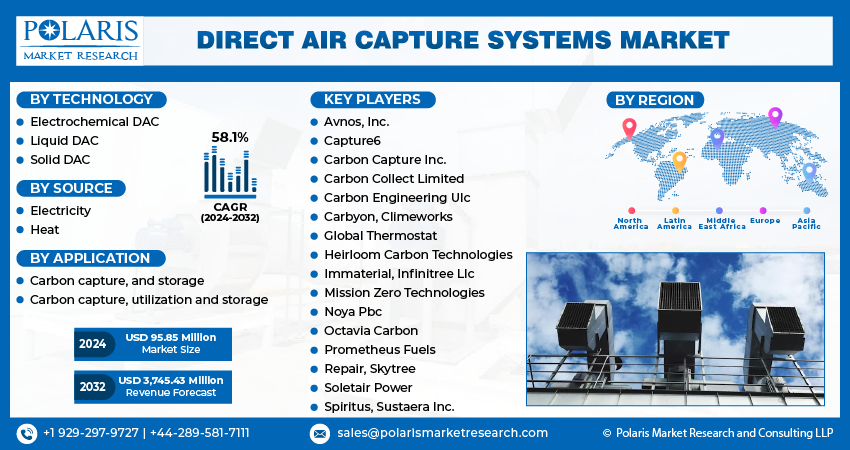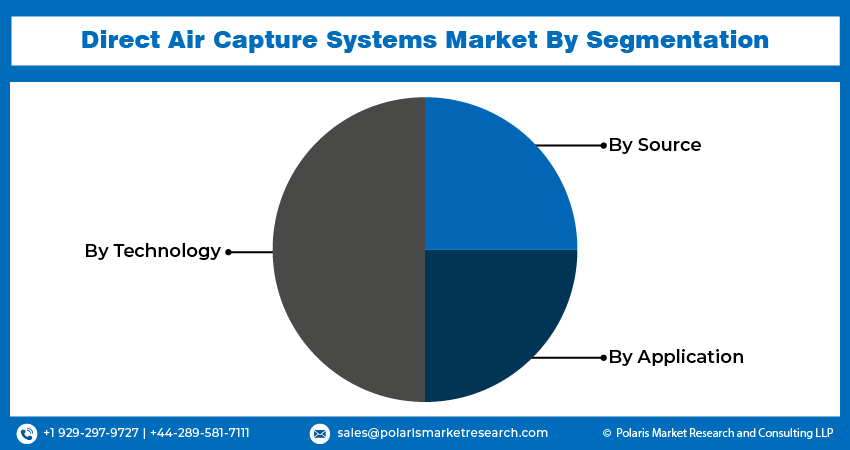
Direct Air Capture Systems Market Share, Size, Trends, Industry Analysis Report
By Technology (Electrochemical DAC, Liquid DAC, and Solid DAC); By Source; By Application; By Region; Segment Forecast, 2024- 2032
- Published Date:Feb-2024
- Pages: 117
- Format: PDF
- Report ID: PM4577
- Base Year: 2023
- Historical Data: 2019 – 2022
Report Outlook
Global direct air capture systems market size was valued at USD 60.66 million in 2023. The market is anticipated to grow from USD 95.85 million in 2024 to USD 3,745.43 million by 2032, exhibiting the CAGR of 58.1% during the forecast period.
Industry Trends
Direct air capture (DAC) is a technology that removes carbon dioxide (CO2) directly from the atmosphere. It involves using various chemical processes or materials to capture CO2 molecules from the air. This captured CO2 can then be stored underground, used for industrial processes, or converted into other useful products. DAC is a potential tool for mitigating climate change by reducing the amount of CO2 in the atmosphere, thereby helping to combat global warming.
Rising global worries about climate change and the urgent need to decrease carbon dioxide levels in the air are pushing the direct air capture (DAC) market forward as a vital tool for removing carbon. Government rules and incentives that promote capturing and storing carbon present chances for adopting DAC systems, along with potential financial benefits and compliance demands. Many companies are dedicated to becoming carbon neutral, which is prompting investments in DAC systems to counterbalance emissions and achieve sustainability goals.
Organizations increasingly recognize the value of collaboration, both internally and externally, to drive innovation and productivity. Within companies, traditional hierarchical structures are giving way to more fluid, team-based approaches where individuals from diverse backgrounds and skill sets come together to tackle complex problems. Beyond organizational boundaries, collaboration extends to partnerships with other companies, research institutions, and even competitors, as organizations recognize the benefits of pooling resources and expertise to achieve common goals. This collaborative landscape fosters a culture of openness, transparency, and mutual support, driving continuous innovation and driving toward shared success.

To Understand More About this Research: Request a Free Sample Report
- For Instance, In September 2023, Climeworks partnered with Great Carbon Valley, an innovative Kenyan company specializing in system integration and project development, to investigate the potential for large-scale projects.
Further, the DAC systems market worth is bolstered by various factors, including supportive government policies, corporate sustainability initiatives, technological advancements, and growing public awareness about the importance of carbon removal technologies. Additionally, significant investments and funding from governments, private investors, and philanthropic organizations contribute to the market's growth and expansion.
However, the enlargement of industry overview, including methods like carbon pricing and trading offsets, provides opportunities for DAC projects to make money from the carbon they capture. Continuous research and development due to better efficiency, lower costs, and increased scalability of DAC systems, making them more appealing and practical. Growing public awareness of climate change issues and increasing investments, both private and public, in clean energy and carbon capture projects are creating a favorable environment for the DAC market growth.
Key Takeaways
- North America dominated the largest market and contributed to more than 40% of share in 2023.
- Asia Pacific is expected to witness the fastest CAGR during the forecast period.
- By technology category, Electrochemical DAC segment held the largest market share in 2023.
- By application category, the carbon capture, utilization and storage (CCUS) segment are expected to grow at the fastest CAGR during the forecast period.
What are the market drivers driving the demand for direct air capture systems market?
Rising Focus on Achieving Global Net Zero Emissions is projected to spur market growth.
Nations worldwide are signing onto international agreements such as the Paris Agreement and making commitments to achieve net-zero emissions by mid-century or soon after. These agreements set a framework for coordinated action on climate change and drive the adoption of technologies like DAC to remove carbon dioxide from the atmosphere. Many corporations are setting ambitious net-zero emission targets as part of their sustainability strategies. To meet these goals, companies are investing in carbon removal technologies, including DAC systems, to offset their remaining emissions and achieve carbon neutrality across their operations and supply chains.
Growing public awareness of the climate crisis and calls for urgent action are putting pressure on governments, businesses, and institutions to prioritize emission reduction efforts. As public concern over climate change increases, there is greater support for policies and initiatives aimed at achieving net-zero emissions, including the use of DAC technology.
Which factor is restraining the demand for Direct Air Capture Systems?
The significant energy consumption and environmental impact linked with the direct air capture systems market pose a major obstacle.
An additional challenge lies in the substantial energy consumption inherent in Direct Air Capture (DAC) processes. Most DAC technologies employ energy-intensive chemical processes or large-scale mechanical systems, which significantly contribute to their environmental impact. This high energy demand not only increases operational costs but also poses sustainability concerns, particularly if the energy used originates from non-renewable sources. In such cases, the carbon reduction benefits of DAC could be compromised by the emissions generated during energy production.
Addressing this challenge requires enhancing the energy efficiency of DAC systems and integrating them with renewable energy sources. By optimizing processes and implementing innovative technologies, DAC developers can minimize energy consumption and reduce environmental impact. Moreover, coupling DAC facilities with renewable energy sources such as solar, wind, or hydroelectric power can mitigate carbon emissions associated with energy usage, enhancing the overall sustainability of DAC solutions. Finding effective ways to balance energy consumption with environmental considerations is crucial for ensuring the long-term viability and effectiveness of DAC technology in combatting climate change.

Report Segmentation
The market is primarily segmented based on technology, source, application, and region.
|
By Technology |
By Source |
By Application |
By Region |
|
|
|
|
To Understand the Scope of this Report: Speak to Analyst
Category Wise Insights
By Technology Insights
Based on technology analysis, the market is segmented on the basis of electrochemical DAC, liquid DAC, and solid DAC. The Electrochemical DAC segment held the largest market share in 2023. However, considering the potential trends and developments in Direct Air Capture (DAC) technology, Electrochemical DAC could emerge as the largest segment. Electrochemical DAC has gained attention due to its potential for high efficiency and scalability, making it a promising approach for capturing carbon dioxide from the atmosphere. Additionally, advancements in electrochemical processes and materials may further drive the adoption of Electrochemical DAC systems.
By Application Insights
Based on application analysis, the market has been segmented based on CCS and CCUS. The carbon capture, utilization, and storage (CCUS) segment is expected to grow at the fastest CAGR during the forecast period. The CCUS not only captures carbon emissions but also finds productive uses for the captured CO2, creating additional economic value. The utilization aspect of CCUS, which involves repurposing CO2 for applications such as enhanced oil recovery, synthetic fuel production, or industrial processes, can incentivize investment and adoption of carbon capture technology.
Additionally, CCUS projects often have access to revenue streams from the products generated through carbon utilization, which can help offset the costs of carbon capture and storage. This economic incentive makes CCUS more attractive to industries and investors, potentially due to faster growth in the forecast period compared to traditional CCS projects.

Regional Insights
North America
North America dominated the largest direct air capture systems market share in 2023. This dominance is attributed to robust technological advancements, substantial private and public investments, and a strong dedication to combating climate change. The region has witnessed a surge in direct air capture systems technology development and deployment, supported by favorable government policies, a well-established entrepreneurial ecosystem, and heightened awareness regarding the necessity of carbon capture and removal solutions.
Asia Pacific
The Asia Pacific region is expected to witness the fastest-growing region with a healthy CAGR during the projected period; the Asia-Pacific region emerges as the fastest-growing market size for DAC systems. This rapid growth is fueled by the region's burgeoning economy, increasing industrialization, and growing awareness of environmental sustainability. Countries across Asia-Pacific are investing significantly in clean technologies, including DAC, driven by high population density and industrial activity. This heightened focus on innovative approaches to mitigate carbon emissions positions Asia-Pacific as a pivotal growth center for the direct air capture systems industry analysis.

Competitive Landscape
The direct air capture systems market is characterized by fragmentation and is poised for increased competition due to the presence of numerous players. Anticipated growth in the market is fueled by major industry players making substantial investments in research and development to expand their product offerings. The market Key companies advancements include the launch of new products, large-scale mergers and acquisitions, contractual agreements, and collaborations with other companies. Market participants actively engage in these activities to enhance their market positions.
Some of the major players operating in the global market include:
- Avnos, Inc.
- Capture6
- Carbon Capture Inc.
- Carbon Collect Limited
- Carbon Engineering Ulc
- Carbyon
- Climeworks
- Global Thermostat
- Heirloom Carbon Technologies
- Immaterial
- Infinitree Llc
- Mission Zero Technologies
- Noya Pbc
- Octavia Carbon
- Prometheus Fuels
- Repair
- Skytree
- Soletair Power
- Spiritus
- Sustaera Inc.
Recent Developments
- In November 2023, Heirloom Carbon Technologies entered into a partnership with CarbonCure, a major manufacturer specializing in carbon removal and utilization technologies aimed at capturing CO2 from the atmosphere and securely embedding it within concrete. Within this collaboration, CarbonCure will be responsible for the permanent storage of CO2 captured by Heirloom's Direct Air Capture (DAC) facilities in nearby concrete plants.
- In May 2023, Sumitomo Corporation announced its investment in Global Thermostat's direct air capture technology. The partnership between the two entities has been solidified through an agreement to collaboratively develop and promote an innovative range of carbon capture and sequestration solutions.
Report Coverage
The direct air capture systems market report emphasizes key regions across the globe to provide a better understanding of the product to the users. Also, the report provides market insights into recent developments, and trends and analyzes the technologies that are gaining traction around the globe. Furthermore, the report covers an in-depth qualitative analysis about various paradigm shifts associated with the transformation of these technology.
The report provides detailed analysis of the market while focusing on various key aspects such as competitive analysis, technology, source, application, and their futuristic growth opportunities.
Direct Air Capture Systems Market Report Scope
|
Report Attributes |
Details |
|
Market size value in 2024 |
USD 95.85 million |
|
Revenue forecast in 2032 |
USD 3,745.43 million |
|
CAGR |
58.1% from 2024 – 2032 |
|
Base year |
2023 |
|
Historical data |
2019 – 2022 |
|
Forecast period |
2024 – 2032 |
|
Quantitative units |
Revenue in USD million and CAGR from 2024 to 2032 |
|
Segments covered |
By Technology, By Source, By Application, By Region |
|
Regional scope |
North America, Europe, Asia Pacific, Latin America; Middle East & Africa |
|
Customization |
Report customization as per your requirements with respect to countries, region and segmentation. |
FAQ's
The global direct air capture systems market size is expected to reach USD 3,745.43 million by 2032
Key players in the market are Avnos, Inc., Capture6, Carbon Capture Inc., Carbon Collect Limited, Carbon Engineering Ulc, Carbyon, Climeworks
North America contribute notably towards the global Direct Air Capture Systems Market
Direct Air Capture Systems Market exhibiting the CAGR of 58.1% during the forecast period.
The Direct Air Capture Systems Market report covering key segments are technology, source, application, and region.
